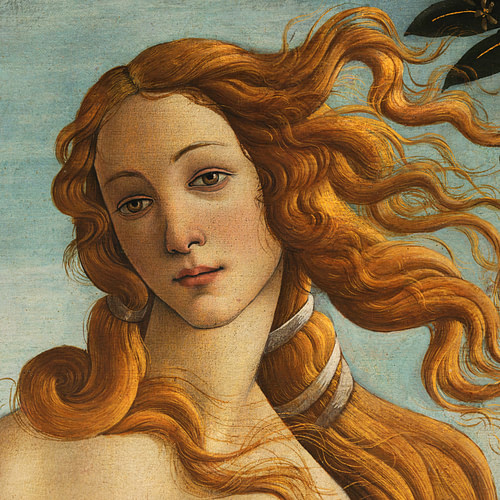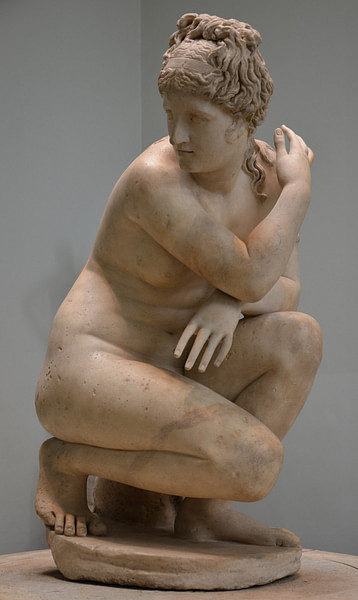
In Roman mythology, Venus was the goddess of love, sex, beauty, and fertility. She was the Roman counterpart to the Greek goddess Aphrodite. However, Roman Venus had many abilities beyond the Greek Aphrodite; she was a goddess of victory, fertility, and even prostitution. According to Greek mythology, as presented in Hesiod's Theogony, Aphrodite was born of the foam from the sea after Saturn (Cronus) castrated his father Uranus (Ouranos) and his blood fell to the sea. This latter explanation appears to be more a popular theory due to the countless artworks depicting Venus rising from the sea in a clam.
Divine Lovers & Children
Venus had two main divine lovers: her husband Vulcan (Hephaistos) and Mars (Ares). There is a myth concerning Venus' and Mars' love affair and how Vulcan cunningly trapped them in bed with a net. Therefore, Vulcan and Venus had a loveless marriage and no children. Albeit, the goddess of love and sex was not barren; she had many children from different gods. With Mars, she gave birth to Timor (Phobos) the personification of fear who accompanied his father into battle, his twin Metus (Deimos) the personification of terror, Concordia (Harmonia) the goddess of harmony and concord, and the Cupids (Erotes) who were a collection of winged love deities who represented the different aspects of love.
The Roman poet Ovid recounts that Aphrodite bore Hermaphroditos by Hermes, who was the epitome of effeminacy and androgyny. She also bore with either Hermes or Zeus, Fortuna (Tyche) who was the personification of luck and fate within Roman religion. Venus is ascribed as the mother of the minor deity Priapus (a fertility god often characterized with an absurdly large phallus) by Bacchus. According to Pausanias, the Graces were thought to be the offspring of Venus and Bacchus, but more commonly their birth is credited to Jupiter and Eurynome. However, the Graces were part of Venus' retinue along with the Cupids and Suadela, the goddess of persuasion in the realms of romance, love, and seduction.
Mortal Lovers, Children, & Descendants
Venus had several mortal lovers as well. The two most famous would be Anchises and Adonis, but she was also the lover of the Sicilian king Butes and mother to their son Eryx, and she also had a son with Phaethon, Astynous. Ovid's Metamorphoses (Book X) recounts how Venus fell in love with the mortal Adonis (either due to his beauty or Cupid's arrow) and besought Proserpina (Persephone) to care for him until she came for him. The two goddesses both grew enamored with the mortal, so they fought until Zeus decided that Adonis would spend one-third the year with each of them and a third wherever he pleased. Ultimately, he spent his time with Venus until he was killed by a boar.
According to the Homeric Hymn to Aphrodite, Anchises, a prince from Dardania and ally to Troy, was seduced by Venus. She disguised herself as a Phrygian princess and seduced him; it was only nine months later that she revealed her divine identity. She presented Anchises with their son Aeneas. Venus warned Anchises never to brag about their affair lest he be struck by Jupiter. Unfortunately, Anchises did brag and was crippled by Jupiter's bolt. The Trojan Aeneas, according to Virgil's Aeneid, was fated to found Rome guided by his divine mother Venus. Aeneas' son Ascanius or Iulus, a king of Alba Longa, was credited, by Virgil, to be the ancestor of the founders of Rome: Romulus and Remus along with the Gens (family) Julia. The Gens Julia was the family that included Julius Caesar, Augustus (Octavian) Caesar, and his descendants.
Temples, Cults, & Festival in Ancient Rome
The first appearance of a temple to Venus was in 295 BCE. It was to Venus Obsequens (Obedient Venus) on the Aventine Hill by Q. Fabius Gurges. However, this temple was diffused with Greek aspects (Aphrodite's cults) and was not a new creation. In 217 BCE, the Sibylline oracle suggested that if Rome (at that time losing the Second Punic War) could persuade Venus Erycina (Venus of Eryx) to change her allegiance from the Carthaginian Silician allies to the Romans, the war would be won. Rome laid siege to Eryx, offered the goddess a magnificent temple, and took her image back to Rome. It was this foreign image that eventually became Rome's Venus Genetrix (Venus the Mother). The cult forming around Venus Genetrix on the Capitoline Hill was reserved for the higher classes, but in 181 BCE and 114 BCE, the temples and cult of Venus Erycina and Venus Verticordia (Venus the changer of hearts) were established for the plebeians.
Venus' month was April (the beginning of spring and fertility) when most of her festivals were held. On 1 April a festival was held in honor of Venus Verticordia called Veneralia. On the 23rd, Vinalia Urbana was held which was a wine festival belonging to both Venus (goddess of profane wine) and Jupiter. Vinalia Rusticia was held on 10 August. It was Venus' oldest festival and associated with her form as Venus Obsequens. 26 September was the date for the festival of Venus Genetrix, the mother and protector of Rome.
Venus & Politics
At the close of the Roman Republic, some Romans laid claim to Venus' favor and competed for it, such as Sulla (adopting the name Felix, Latin for lucky, and accrediting Venus Felix to his divine favor), Pompey (who dedicated, in 55 BCE, a temple to Venus Victrix - Venus of Victory), Julius Caesar (who claimed favor with Venus Victrix and Venus Genetrix), and Hadrian (who, in 139 CE, dedicated a temple to Venus and Roma Aeterna - Eternal Rome - making Venus the protective mother of the Roman state).
Venus & The Evening Star
In Virgil's Aeneid, the Trojan hero Aeneas is led to Latium by his mother in her celestial form: the evening star. It is this same star which Virgil accounts lifts Julius Caesar's soul to the heavens. This is also the secondary name for the planet Venus because it so bright and discernible in the night's sky.
Art & Appearance
Images of Venus have been found in countless forms from sculptures to mosaics to shrines and even domestic murals and fresco. Venus, due to her natural beauty and sexual nature, was often depicted nude. Most sculptures of Venus resembled a close similarity to the Aphrodite of Cnidus and the Venus de Milo. However, there are many fine wall paintings from Pompeii that depict Venus in different forms. Venus continued to be a popular subject matter for artists through antiquity and the Renaissance even into the 20th century.













